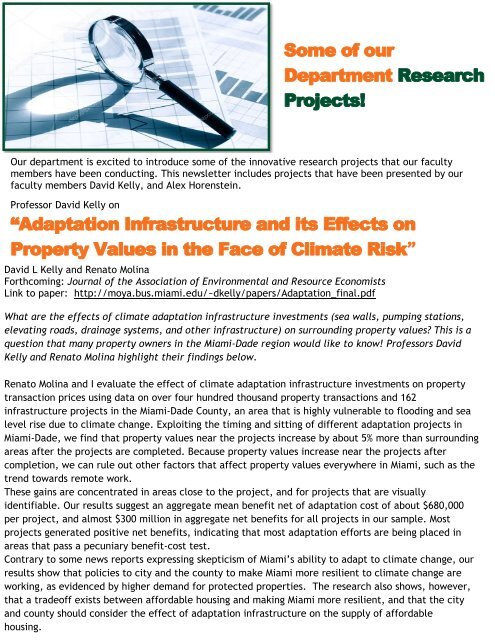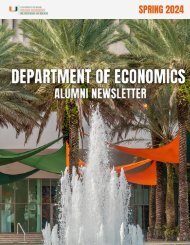ECONOMICS ALUMNI NEWSLETTER
You also want an ePaper? Increase the reach of your titles
YUMPU automatically turns print PDFs into web optimized ePapers that Google loves.
Our department is excited to introduce some of the innovative research projects that our faculty<br />
members have been conducting. This newsletter includes projects that have been presented by our<br />
faculty members David Kelly, and Alex Horenstein.<br />
Professor David Kelly on<br />
David L Kelly and Renato Molina<br />
Forthcoming: Journal of the Association of Environmental and Resource Economists<br />
Link to paper: http://moya.bus.miami.edu/~dkelly/papers/Adaptation_final.pdf<br />
What are the effects of climate adaptation infrastructure investments (sea walls, pumping stations,<br />
elevating roads, drainage systems, and other infrastructure) on surrounding property values? This is a<br />
question that many property owners in the Miami-Dade region would like to know! Professors David<br />
Kelly and Renato Molina highlight their findings below.<br />
Renato Molina and I evaluate the effect of climate adaptation infrastructure investments on property<br />
transaction prices using data on over four hundred thousand property transactions and 162<br />
infrastructure projects in the Miami-Dade County, an area that is highly vulnerable to flooding and sea<br />
level rise due to climate change. Exploiting the timing and sitting of different adaptation projects in<br />
Miami-Dade, we find that property values near the projects increase by about 5% more than surrounding<br />
areas after the projects are completed. Because property values increase near the projects after<br />
completion, we can rule out other factors that affect property values everywhere in Miami, such as the<br />
trend towards remote work.<br />
These gains are concentrated in areas close to the project, and for projects that are visually<br />
identifiable. Our results suggest an aggregate mean benefit net of adaptation cost of about $680,000<br />
per project, and almost $300 million in aggregate net benefits for all projects in our sample. Most<br />
projects generated positive net benefits, indicating that most adaptation efforts are being placed in<br />
areas that pass a pecuniary benefit-cost test.<br />
Contrary to some news reports expressing skepticism of Miami’s ability to adapt to climate change, our<br />
results show that policies to city and the county to make Miami more resilient to climate change are<br />
working, as evidenced by higher demand for protected properties. The research also shows, however,<br />
that a tradeoff exists between affordable housing and making Miami more resilient, and that the city<br />
and county should consider the effect of adaptation infrastructure on the supply of affordable<br />
housing.




